
The support leader’s guide to proactive support: Provide help before it’s needed
Today, customer expectations are at an all-time high. Simultaneously, support teams are struggling with spikes in conversation volumes. A proactive customer support approach is the key to regaining control.
The typical support “strategy” is to let common issues roll in for your support team to address. But this approach not only overwhelms your team, it also means customers frequently have to wait hours or even days to get the help they need. This is costly not just for your team’s bandwidth and budget – but also for your customers’ satisfaction and overall perception of your brand.
Instead of deflecting conversations, your team can prevent common issues from occurring in the first place. With the right strategy and proactive support tools – think Outbound Messages, Product Tours, Mobile Carousels, and Banners – you can alert customers to known issues, like delivery delays, bugs in your product, and website downtime.
You can also onboard and educate new customers so they’re set up for success with your product from day one and have all of the information they need to get started and overcome common hurdles, such as configuring your app or installing it on mobile.
Proactive support can drastically reduce the number of conversations that reach your support team, all while increasing customer satisfaction and retention. Below, we share the latest and greatest proactive support strategies – including how to automatically identify recurring customer issues, preemptively resolve customer queries with targeted messages, and ultimately, position support as a core value driver for your business.
Why proactive support is your first line of defense
At Intercom, we use a framework called the Support Funnel to deliver fast, personal support to our customers. Proactive support is at the top of the Support Funnel for a reason – it’s your first line of defense.
With the funnel, you can combine proactive, self-serve, and human support capabilities to get ahead of known problems before they arise, automatically answer repetitive queries, and quickly resolve complex issues.

Armed with the right proactive support approach, you can significantly reduce the number of queries that reach your support team’s inbox, all while keeping your customers satisfied. Proactive support has a positive knock-on effect on every layer of the funnel – for instance, when most of your customers’ queries are resolved proactively, it frees up your support team to focus on your most pressing, complex, and VIP support queries. They’ll have more time and headspace to help top tier customers solve their thorny problems in a truly personal way.
“78% of support leaders want to move to a more proactive support approach, but only 26% are sure they have the knowledge and tools to do so”
With proactive support leading the charge, not only will you take pressure off your team, you can also demonstrate how support is impacting your business’ bottom line with positive customer loyalty and retention figures.
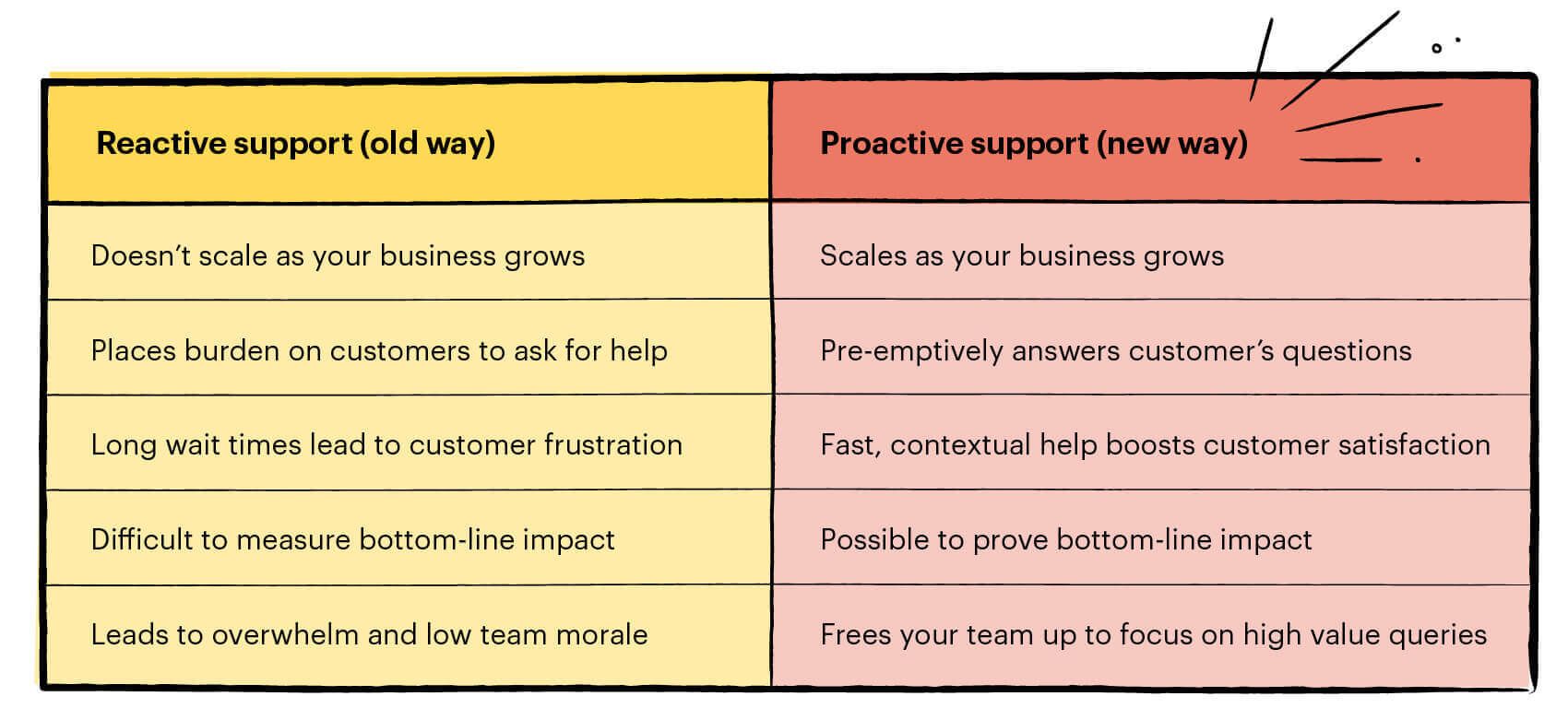 With all of these powerful benefits, it’s no surprise that a survey we ran with almost 600 support leaders revealed that 78% of support leaders want to move to a more proactive support approach. However, only 26% are sure they have the knowledge and tools to do so.
With all of these powerful benefits, it’s no surprise that a survey we ran with almost 600 support leaders revealed that 78% of support leaders want to move to a more proactive support approach. However, only 26% are sure they have the knowledge and tools to do so.
Preemptively identify recurring customer issues
By now, you may be thinking, “Proactive support sounds great – it’s the Holy Grail of support!” But when your team is so busy managing day-to-day reactive conversations you may be wondering how you’ll find time to identify recurring customer questions and pain points, so you can begin proactively resolving issues.
“A modern conversational support tool will automatically surface your customers’ most common issues to your team”
The right tools will automatically do a lot of the groundwork for you, preventing unnecessary headaches for your support team and helping them reclaim valuable time. Armed with these insights, you can pinpoint exactly how to improve your team’s effectiveness, improve resolution times, and enhance customer satisfaction. Here are our tips:
Gather valuable conversation data fast
A modern customer communications platform like Intercom will automatically surface your customers’ most common issues and pressing questions to your team – removing the need to manually tag conversations or go digging for details. You’ll also be able to quickly see how effective your team is at resolving these issues at a glance.

For example, with Intercom you can:
- View AI-powered suggestions to see the topics your customers are writing in about most.
- Quickly see how effective your team is at resolving each type of issue, and how much time it’s taking to reach a resolution.
- Unlock trends and insights from customer conversations that help improve teammate efficiency and boost customer satisfaction and loyalty.
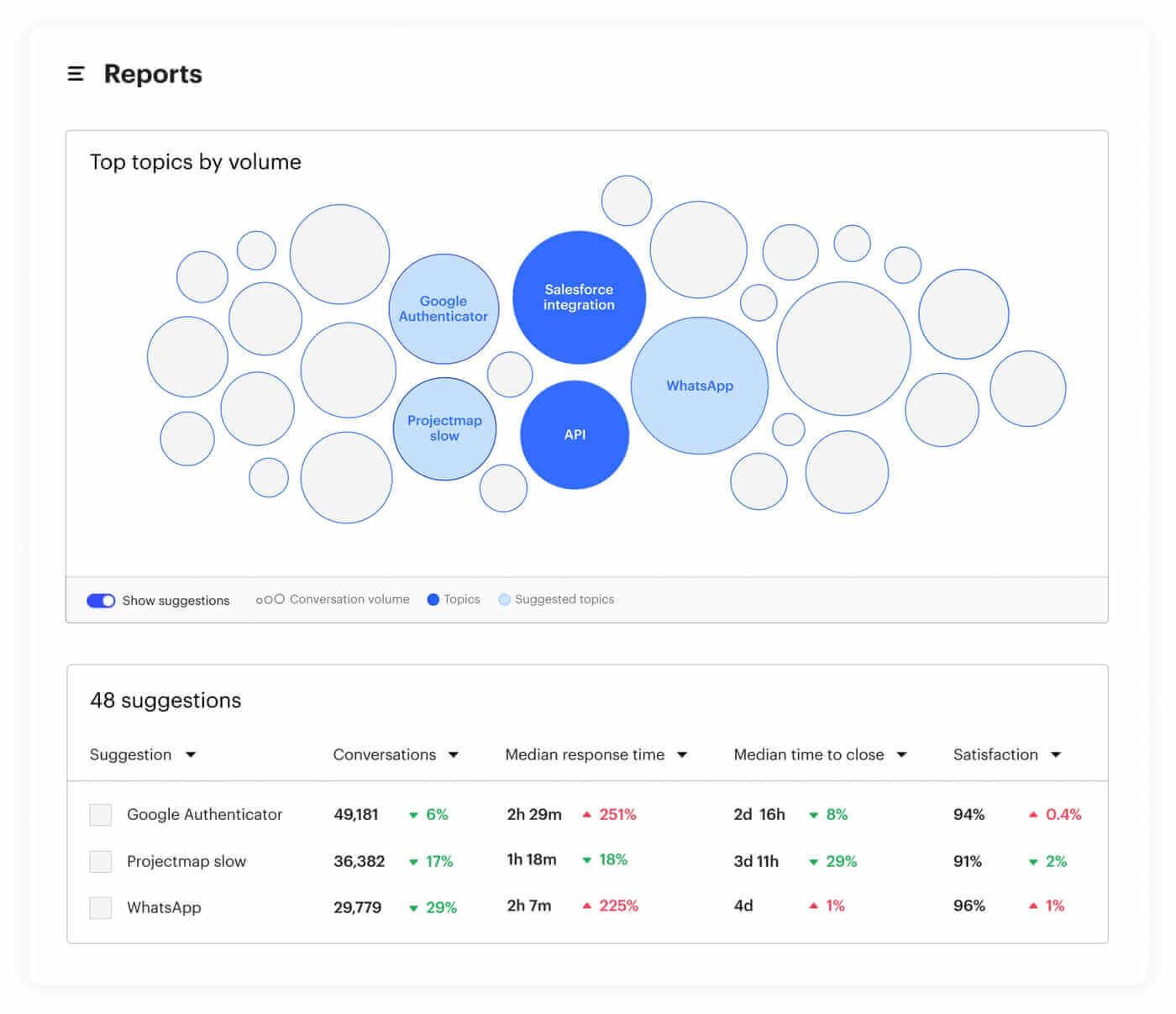
Partner cross-functionally for maximum impact
No support team should ever be an island. Getting ahead of customer issues and providing a great proactive customer experience is everyone’s responsibility in your company and that makes collaboration critical to success.
“Keep open lines of communication with every customer-facing team so you can share critical insights that drive business growth”
Your support team is in a unique position – you know your customers’ pain points, questions, and desires better than anyone else. Make sure your team has open lines of communication with every customer-facing team – from product to marketing to sales – so you can share eye-opening, critical insights that help drive business growth, improve your product or service, and more.
For example, at Intercom our Support team regularly:
- Shares the top topics customers have questions about with our Product Education team so they can address these topics in our Outbound Messages, Product Tours, and Academy training courses.
- Surfaces top feature requests and product pain points to our Product team so they can fix mission-critical issues and create a more customer-centric roadmap.
- Partners with Sales to streamline conversation passing for a better customer experience and to maximize revenue-generation opportunities.
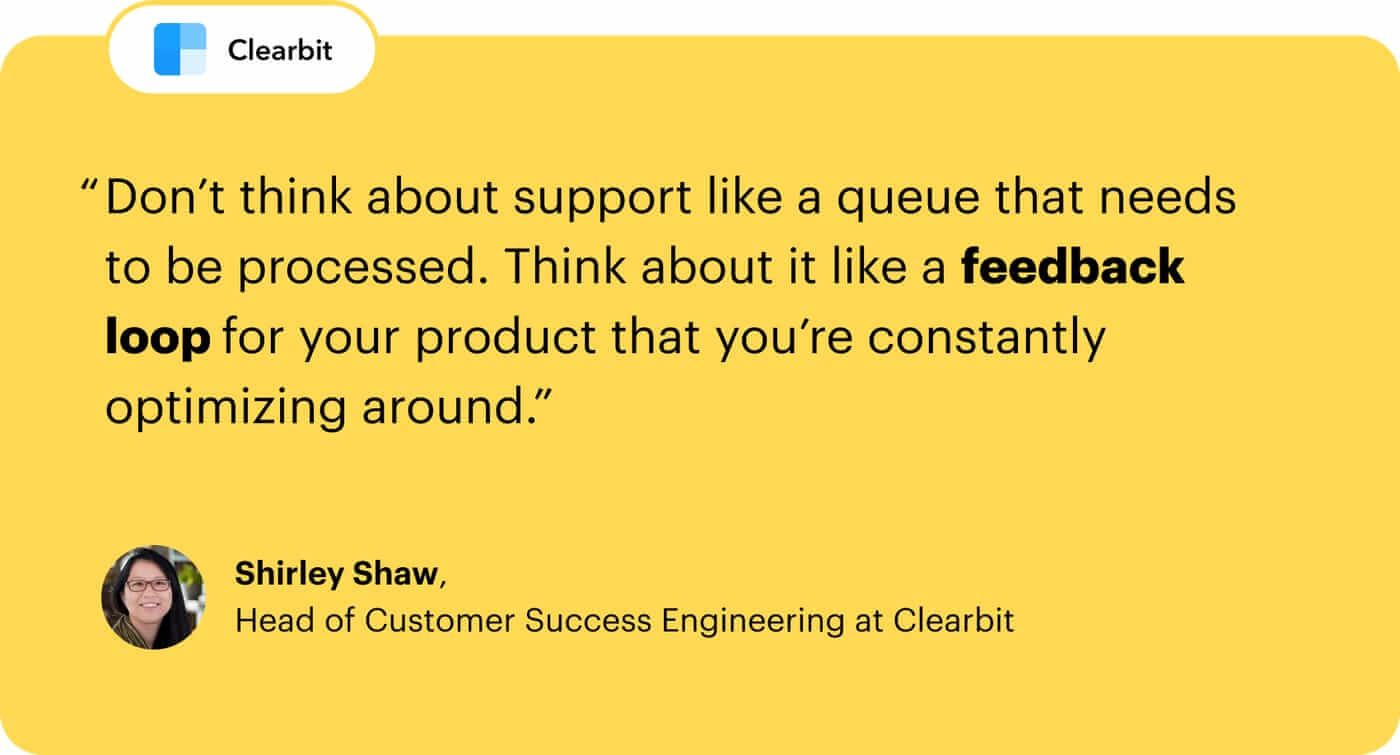
Create a customer feedback loop
Quantitative data is meaningful. But it won’t help you fully understand all of the context behind your customers’ pain points. Often, you’ll be left with questions like: Why do they have these issues, how do they feel, and where are the stumbling blocks? While reviewing customer conversations is useful, sometimes you need a quick route to unlocking immediately actionable insights – for example, you may want to understand the “why” behind the issues new customers are facing. That’s why it’s important to create a qualitative customer feedback loop where customers can quickly and easily share more detail on their issues.
“You’ll know the exact questions to address in your help content and the precise words to use – your customers’ words”
One of the best ways to do this is create a feedback message. For example, you can check in with customers who are trialing a beta of your new product to get context on any issues they’re experiencing. Then, by the time you launch your new product you’ll know the exact questions to address in your help content and the precise words to use (yes – your customers’ words).

Pro tip: If you’re using Intercom you can quickly collect qualitative data from a customer by embedding a Typeform survey into the Intercom Messenger.
4 powerful proactive support messages to send
Now you know your customers’ most common pain points, you’ll have a better idea of the types of messages that will help them overcome issues, navigate tricky features, and ultimately, achieve success with your product or service.
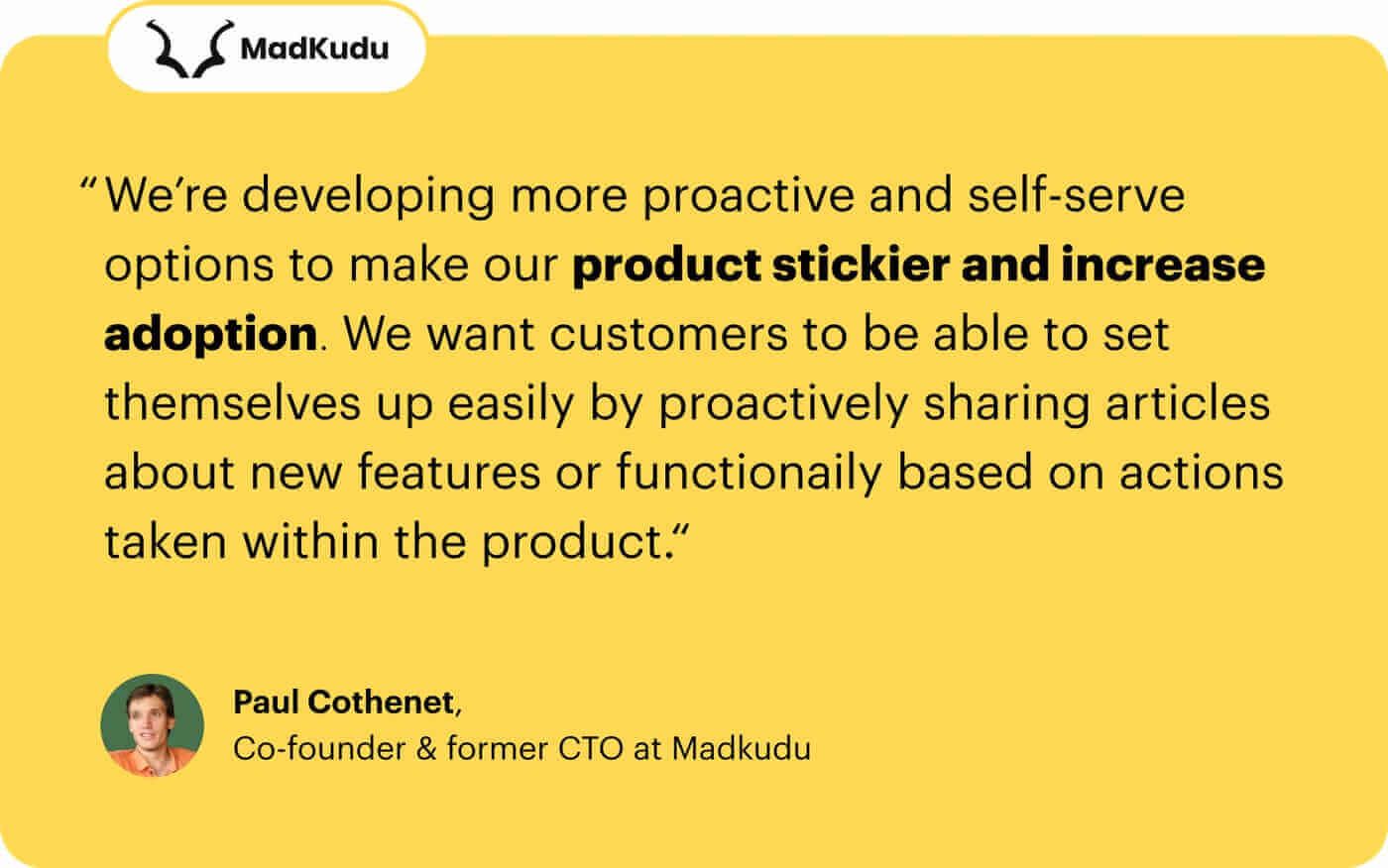
Regardless of your business type and customer needs, there are four powerful proactive messages your team should set up:
1. Onboard new customers
There’s nothing more exciting than when a new customer signs up for your product or service. But, of course, newbies will often experience a steep learning curve. That’s especially true if your product or service is a little more complex. While new customers are learning the ropes they can require quite a bit of hand-holding. Their questions are often directed at your busy support team, which can clog up your support queue.
“Giving customers proactive guidance from the outset not only increases customer satisfaction and retention, it also helps keep them out of the inbox”
An overflowing inbox doesn’t have to be the status quo. You can set up a Product Tour or Mobile Carousel to automatically walk new customers through setting up and configuring your product, getting value upfront, and navigating known pain points. Giving customers proactive guidance from the outset not only increases customer satisfaction and retention, it also helps keep them out of the inbox.
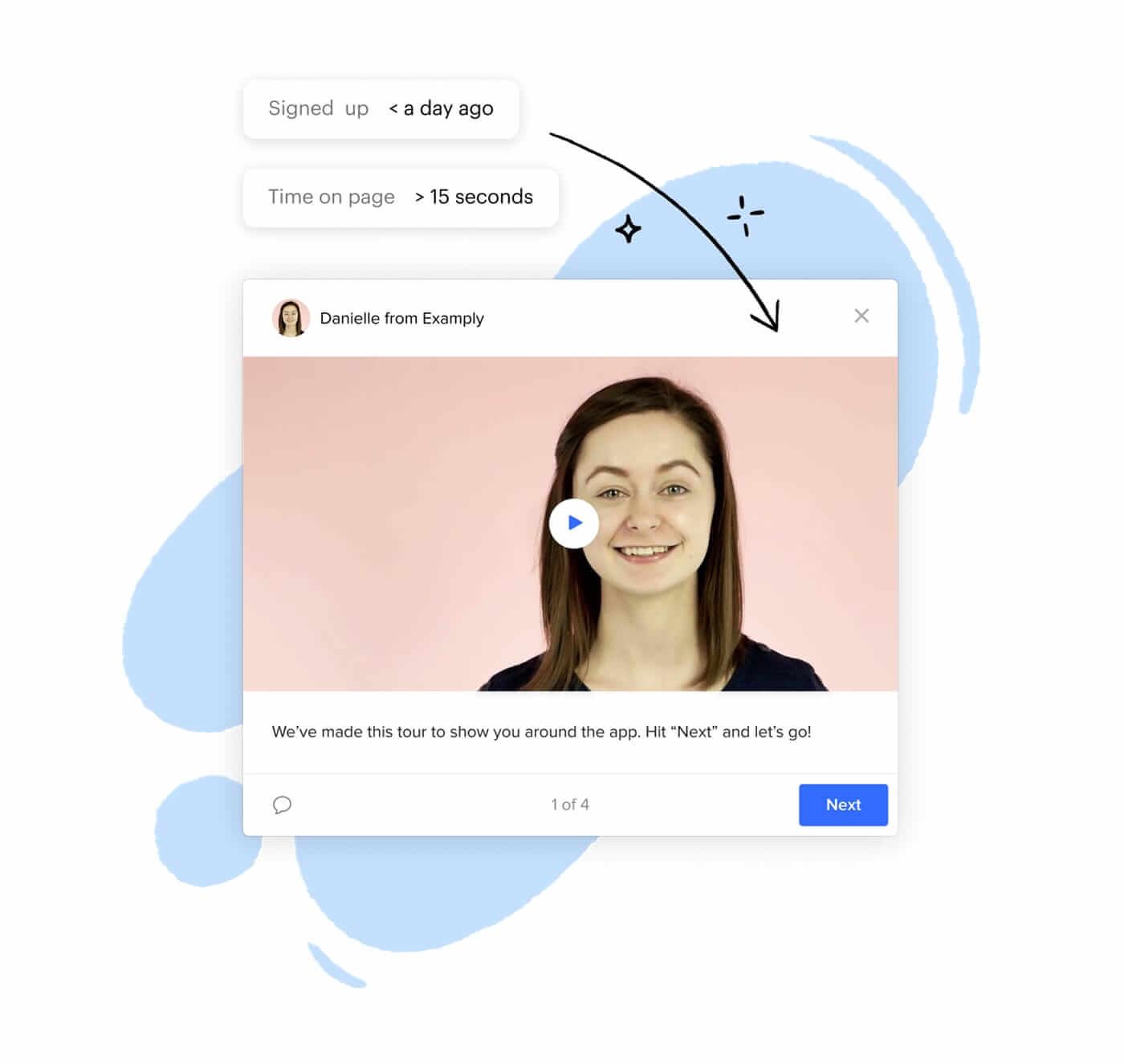
2. Address common stumbling blocks
When customers are browsing your website or using your product, they may encounter a stumbling block, like a processing error or not being able to find the details they need on how to use a specific feature. They’ll have questions like: “Why isn’t my data saving?” or “What are your shipping times?”
By proactively identifying these stumbling blocks ahead of time, you could save your customers time writing into your support team. For example, if a customer is trying to purchase an item on your e-commerce store, but their payment fails, you can trigger an automated message to pop up at that exact moment, providing helpful troubleshooting tips.

3. Educate customers on new features
Even when customers have been using your product or service for a while, when you release new features or add-ons, they’re bound to have questions. Usually your team will brace for a large tsunami of queries on launch week. If you can anticipate your customers’ questions ahead of time you’ll be able to reduce the tide of incoming queries. For example, you can automatically send a message to customers once they add your new feature and prompt them to check out your FAQs. This will empower them to answer their own questions in their own time.

4. Alert customers to known issues
No matter how diligent your business is, day-to-day issues can occur with your product or service that can affect your customers. Think product outages, website downtime, bugs, delays with delivery – all those mission critical issues that can frustrate your customers and wipe out your team’s entire day. Instead of waiting for a flood of issues to come rushing in for your team to address, you can proactively send an outbound message to flag the issue and provide help upfront.
For example, if you’ve recently experienced a vulnerability with your premium product, you could message your premium customers who logged in within the last 10 days.
Metrics for championing and improving proactive support
Proactive support helps you elevate the support function within your company, so your team can go from drowning in reactive conversations (the old way) to carving out more time to become strategic, revenue-generating business partners (the new conversational way).
One of the best ways to position support as a key value driver is to get buy-in from other teams and to co-own support efficiency and bottom-line metrics together. Having a clear, collective goal and measurable metrics to work towards will inspire you to band together and help each other succeed. If you can draw a direct correlation to boosting your business’ bottom line, even better. Here are some key metrics to measure:
- Rate of Automated Resolution (ROAR). By adopting a proactive approach at Intercom we’re currently hovering at around a 4.5% Rate of Automated Resolution (ROAR), which means 4.5% of all customer issues are resolved without a human being involved. This translates to about $400,000 saved per year.
- Conversations closed by articles. If someone reads one of our help center articles linked to from a proactive message, they’ll be prompted to let us know whether it answered their question. If they indicate the question is resolved by giving it a thumbs up we’ll track that as part of our “conversations closed by articles” rate.
- Customer retention. Retention is one of the most important bottom-line metrics for any SaaS or subscription-based business to measure. At Intercom, this is the Holy Grail metric we use to measure the impact of our customer training, webinars, and more, which are all a key part of our proactive support strategy.
- Product engagement metrics. Our Product Education team measures the activation rate for important features we know are more likely to retain customers. If we send an Outbound Message encouraging customers to use a feature for the first time, for example, we can track whether they’ve taken that action or not.
Learn, iterate, improve!
Support metrics on their own are just numbers on a dashboard. They only become meaningful when you dig deeper, start looking for underlying trends and themes, and use those insights to take the next step toward providing a world-class customer experience. For example, you’ll want to:
- Measure how your proactive messages are performing. Are they engaging customers and resolving issues effectively? If there’s a message that’s underperforming, try tweaking the copy or filters to improve performance.
- If you’re an Intercom customer, you can view Conversation Topics to see the exact topics customers are asking about most. This can help you identify the most helpful proactive messages to create next.
Get the full strategy for delivering fast, personal support at scale
Proactive support is incredibly powerful, but it’s only one piece of the puzzle for delivering efficient, personal support to your customers at the scale your business needs. Learn how to combine proactive, self-serve, and human support with the Engagement OS, and achieve world-class support without burning out your team or budget. Better customer relationships and a more efficient, cost-effective support machine await.







